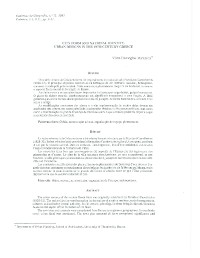Please use this identifier to cite or link to this item:
https://hdl.handle.net/10316.2/40642| Title: | City form and national identity: urban designs in the 19th century Greece | Authors: | Hastaoglou-Martinidis, Vilma | Keywords: | Greece;reconstruction of city;organization of space;planning;Grèce;reconstruction urbaine;organization de l'espaçe;aménagement;Grécia;reconstrução urbana;organização do espaço;planeamento | Issue Date: | 1993 | Publisher: | Faculdade de Letras da Universidade de Coimbra | Abstract: | O cenário urbano da Grécia moderna foi originalmente introduzido pelo Presidente Capodistrias (1828-32). O principal objectivo centrava-se na formação de um território nacional, homogéneo, coerente e unido pelo poder central. Neste contexto, o planeamento, longe de ser acidental, tornou-se o aspecto fundamental da formação do Estado.
As ideias novas e os conceitos foram importados da Europa por engenheiros, geógrafos e outros. O plano da cidade assumia simultaneamente um significado excepcional e uma função. A ideia genérica que estava na base destes planos consistia em justapor, de forma harmoniosa, a cidade nova sobre a antiga.
As modificações constantes dos planos e a não implementação de muitos deles devem ser analisadas não apenas em consequência de inadequadas técnicas ou fraquezas políticas, mas antes como a manifestação da grande diferença de interesses entre o que o Estado pretendia impor e o que a sociedade desejava na realidade. La scène urbaine de la Grèce moderne a été originellement introduite par le Président Capodistrias (1828-32). Le but principal était centre dans la formation d'un térritoire national, homogène, cohérent et uni par le pouvoir central. Dans ce contexte, l'aménagement, loin d'être accidentel, est devenu l'aspect fondamental de la formation de l'Etat. Les nouvelles idées bien que les concepts on été importes de l'Europe par des ingénieurs, des géographes et d'autres. Le plan de la ville assumait simultanément un sens exceptionnel et une fonction. L'idée générique qui soutenait ces plans consistait à juxtaposer harmonieusement la nouvelle ville sur l'ancienne. Les constantes modifications des plans et la non-implémentation de beaucoup d'eux doivent être analysées non seulement en conséquence de techniques inadaptées ou de faiblesses politiques, mais surtout comme la manifestation de la grande différence d'intérêts entre ce que l'Etat prétendait imposer et ce que la société souhaitait en fait. The urban scenery of the modern Greek State was originally introduced by President Capodistrias (1828-32). The main objective was focused on the formation of a nation territory, made homogeneous, coherent and united by central authority. In this context, planning, far from being incidental, became a fundamental aspect of the formation of the State. The new ideas and concepts were transplanted from Europe by engineers, geographers. A completely novel urban ideal was introduced. The town plan assumed de facto exceptional significance and function. The generic idea of these plans was to harmoniously juxtapose the new city to the ancient towns. The constant modification of the plans and the non-implementation of many of them, are therefore to be viewed as not merely due to technical inadequacies or political weakness, but rather a manifestation of the vast gap between what the State wanted to impose and what society could or would do. |
URI: | https://hdl.handle.net/10316.2/40642 | ISSN: | 0871-1623 2183-4016 (digital) |
DOI: | 10.14195/0871-1623_12_1 | Rights: | open access |
| Appears in Collections: | Cadernos de Geografia |
Files in This Item:
| File | Description | Size | Format | |
|---|---|---|---|---|
| city_form_and_national_identity.pdf | 3.46 MB | Adobe PDF |  |
Items in DSpace are protected by copyright, with all rights reserved, unless otherwise indicated.
